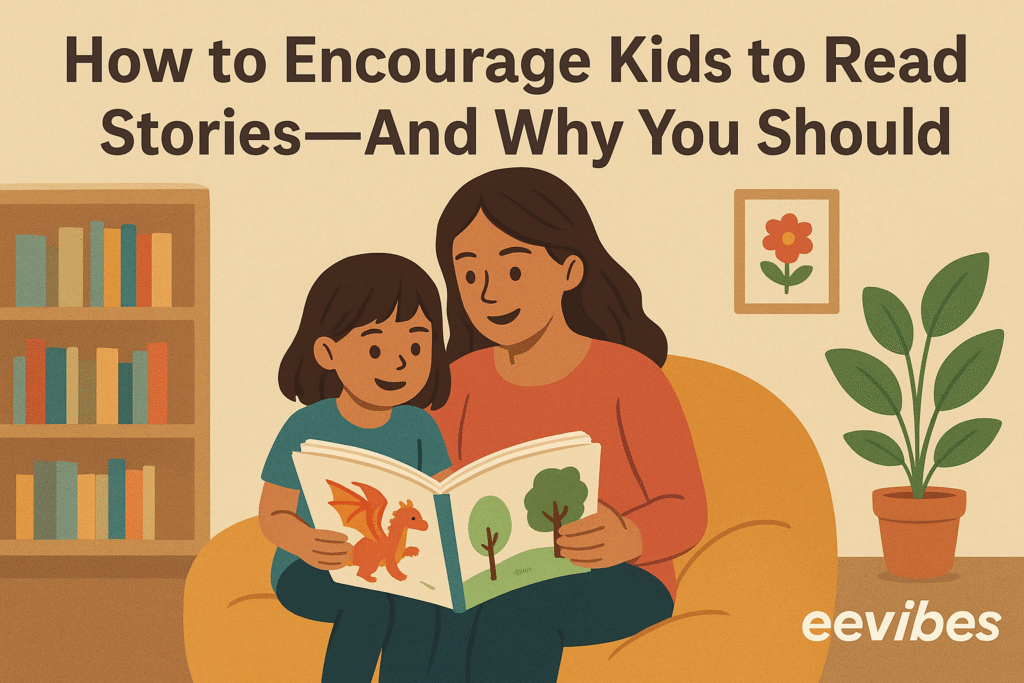
Encouraging kids to read stories is one of the simplest and strongest gifts you can give them. Children naturally love imagination, but they often need the right environment to turn that curiosity into a regular reading habit. Start by creating a small reading corner at home with a few age-appropriate storybooks—some kids are drawn to colorful illustrations, others to adventures or funny characters. Read with them, even if it’s just ten minutes a day; the bonding moments matter as much as the story itself. Let them choose their own books too, because ownership builds interest. Limit screen time a little during the day and replace it with a “story hour.” Celebrate small milestones, like finishing a book or retelling a story in their own words.
Create a Reading-Friendly Environment
Children read more when books are easily accessible and presented in a way that feels inviting. Set up a small, cozy reading corner in your home with cushions, soft lighting, and a small shelf where storybooks are displayed face-out so the covers attract attention. Rotate books once in a while to keep the space exciting. When the environment is pleasant, kids naturally gravitate toward it.
Let Children Choose Their Own Books
Kids feel motivated when they have a say in what they read. Offer them a variety of options—picture books, adventure tales, fairy tales, animal stories, and short chapter books. A child who chooses their own story feels ownership, and this sense of choice makes reading more enjoyable, not a forced task.
Read Together Daily
Children learn through imitation. When they see you reading or hear you reading aloud, they naturally develop interest. Make reading a shared activity—ten to fifteen minutes a day is enough to build a habit. Use expressions, change your voice for characters, and pause to ask questions. These small interactions make stories come alive and turn reading into a time they look forward to.
Reduce Screen Time and Introduce “Story Time”
Screens can easily dominate a child’s attention. Instead of restricting screens abruptly, gently replace some screen time with “story time.” Create a routine—before bed, after school, or during quiet afternoon hours. Children respond well to routine, and with consistency, they start expecting that special reading time.
Use Rewards and Positive Reinforcement
Celebrating small achievements can significantly boost a child’s confidence and interest in reading. Reward them when they finish a book or retell a story in their own words. Stickers, stars, or even simple praise like, “I love how you read that line!” can increase motivation and make reading feel rewarding.
Bring Stories to Life
Make reading interactive. Ask your child to predict what might happen next, act out a scene, or draw their favorite character. Some parents even create mini “story challenges,” like finding certain words or counting how many animals appear. The more fun and participatory the experience, the deeper the child’s engagement.
Visit Libraries and Bookstores
A trip to a library or bookstore can feel like an adventure. Kids enjoy exploring with freedom, flipping through books, and discovering new stories. Many libraries also host storytelling sessions, which can spark a stronger interest in books and help kids meet other young readers.
Why Encouraging Kids to Read Is Essential
Reading does much more than build vocabulary. It enhances imagination, boosts creativity, and develops emotional intelligence by allowing children to step into different characters’ shoes. Kids who read regularly tend to perform better academically, especially in comprehension, writing, and communication. Storybooks teach patience, focus, and problem-solving—skills that stay with them throughout life.
With screens continuously competing for attention, cultivating a reading habit gives children a healthier form of entertainment and learning. It not only enriches their childhood but also shapes them into thoughtful, confident, and curious adults.